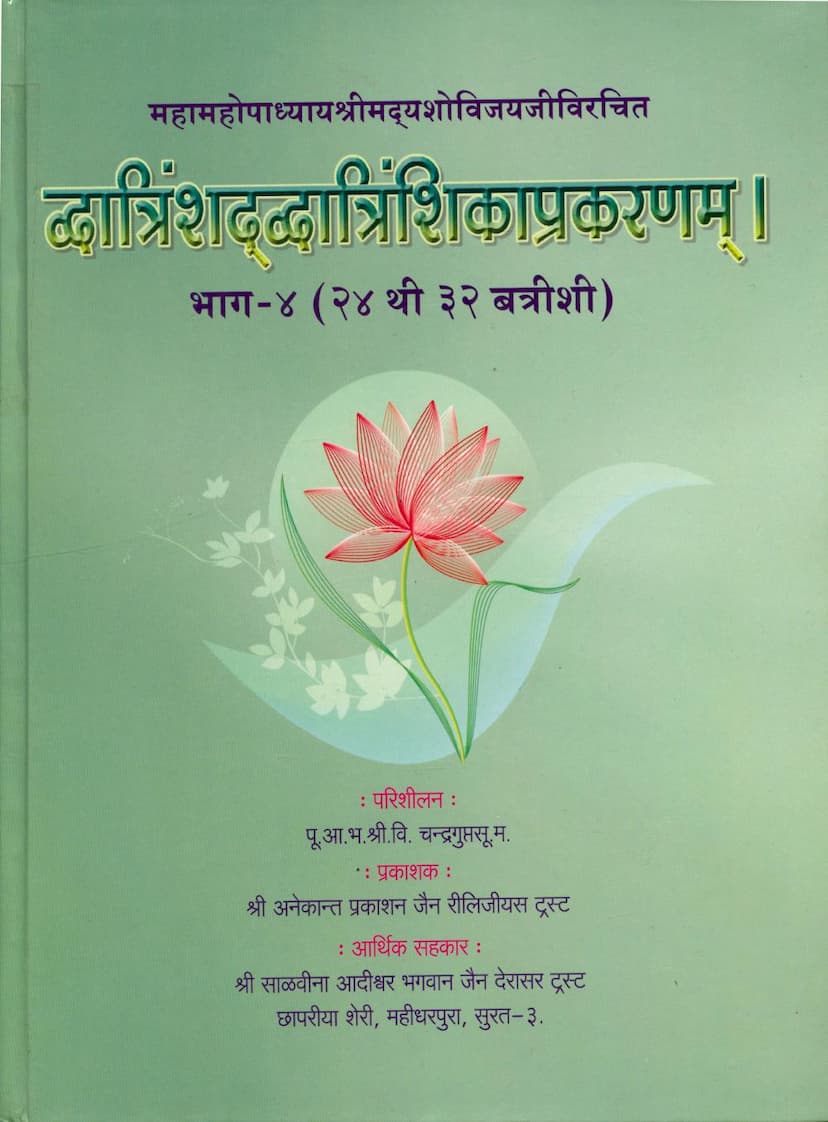Dwatrinshad Dwatrinshika Prakaranam Part 04
Added to library: September 1, 2025

Summary
This document is Part 4 of the "Dwatrinshad Dwatrinshika Prakaranam," a Jain text authored by Chandraguptasuri and published by Anekant Prakashan Jain Religious Trust. This specific part covers the 24th to 32nd "Bātrīśī" (sections of 32 verses each).
The text begins with an introduction that explains the context for this section. It states that after conquering the "Avedyasamvedyapada" (a state beyond perception and conception), which leads to the cessation of faulty reasoning, one attains four types of correct insights (Saddrashti). This fourth part (from the 24th to the 32nd Bātrīśī) is dedicated to describing these four insights. The author emphasizes that this description, based on "Yogadrishti Samucchaya," is very concise and requires careful understanding.
The summary then details the content of the Bātrīśī based on the verses discussed:
-
Sthirā Drishti (Steady Insight): Described in the first seven verses, this insight is compared to the radiance of a gem. It involves "Pratyāhāra" (withdrawal of senses), absence of illusory faults, and attainment of subtle knowledge. The text elaborates on the withdrawal of senses according to other philosophies, defining it as a special state of senses free from subject-object corruption. It highlights that all worldly actions are performed for the sake of modesty. Everything other than the self-knowledge-essence is seen as a disturbance. The pleasure derived from senses and objects is likened to the spreading hood of a serpent, suggesting its transient and ultimately harmful nature. It's noted that even the enjoyment of sense objects obtained through Dharma (righteous conduct) feels meaningless, like fire originating from sandalwood, causing destruction.
-
Kāntā Drishti (Pleasing Insight): Described in verses eight to sixteen, this insight is compared to the halo of a star. It involves "Dhāraṇā" (concentration), absence of the "Anyamudr" (defect of attachment to other things), and the manifestation of "Mīmāṃsā" (contemplation of the true and untrue). Dhāraṇā is defined as the concentration of the mind on a specific point, such as the navel or the tip of the nose. The absence of "Anyamudr" is due to the mind's stability, preventing focus on external objects. This insight leads to a refined understanding, where the mind remains absorbed in Dharma gained through scripture. The pursuit of sense pleasures does not become a cause for rebirth, and the enjoyment of pleasures does not obstruct the path to liberation. The contemplation of the "Sad" (existent) and "Asad" (non-existent) is described as Mīmāṃsā, which prevents indecisive actions in Kāntā Drishti.
-
Prabhā Drishti (Radiant Insight): Described in verses seventeen to twenty-five, this insight is characterized by the essence of "Dhyāna" (meditation) and is free from the defect of "Rujā" (affliction). It prominently features the influence of "Asalānuṣṭhāna" (effortless conduct). The text also mentions its acceptance by other philosophical schools in forms like "Praśāntavāhitā" (calm flow).
-
Parā Drishti (Supreme Insight): Described in the last seven verses, this insight is free from "Āsa" (faults) and filled with "Samādhi" (absorption). Its specialty lies in "Nirācāra" (non-action or absence of ritualistic action).
The summary concludes with a wish that by studying this Bātrīśī, everyone may become capable of journeying towards the abode of supreme bliss.
The text also includes information about the publication, including the first edition, print run (500 copies), price (Rs. 800 for the set of 4 volumes), and contact details for obtaining the book. It also carries a notice recommending that those using the book, printed with funds from a knowledge department, should reciprocate by donating appropriately to the knowledge department or providing suitable copies.
The latter part of the document appears to be a critique or commentary on other philosophical schools (Buddhism, Sāṅkhya, Nyāya) and their views on liberation, refuting their arguments and establishing the Jain perspective. It discusses concepts like Kleśas (defilements), the role of knowledge and righteous conduct, the nature of the soul, the causes of suffering, and the path to liberation, all from a Jain philosophical standpoint.